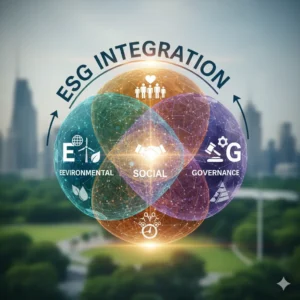The global business landscape is changing fast. Investors, regulators, and customers are no longer satisfied with financial results alone—they want to see how companies create value responsibly. That’s where ESG Integration comes in.
By definition, ESG Integration means systematically embedding environmental, social, and governance factors into financial analysis, corporate strategy, and day-to-day decision-making. Unlike simple screening or one-off sustainability projects, ESG Integration makes non-financial considerations a core part of performance and risk evaluation.
It’s not just about “doing good.” ESG Integration helps organizations anticipate regulatory changes, protect reputation, and identify opportunities for long-term growth.
What Is ESG Integration?
Definition and Principles
- Integrating ESG into business processes is the step of investigating ESG risks and opportunities together with financial results as measured by traditional metrics.
- It considers the factors like greenhouse gas emissions, otherwise known as climate change, racial diversity in the workforce, and environmental, social, and governance (ESG) issues as financially significannt aspects.
ESG Integration vs. Other Approaches
- Prevention is the method that keeps a company from being involved in some practices.
- Innovative social finance is the route of putting funds into projects where social and ecological profits are easily understood.
- ESG Integration relates to mainstream businesses in all sectors by empirical ESG criteria in decision-making.
It is a result of the fact that it is the most inclusive way of financing and being accountable by businesses.
Why Companies and Investors Value ESG Integration
Environmental Benefits
-
Prepares businesses for climate-related risks, such as carbon taxes and stricter emission standards.
-
Encourages investment in renewable energy and efficiency.
Social Benefits
-
Strengthens brand reputation and trust with stakeholders.
-
Promotes diversity, inclusion, and fair labor practices.
Governance Benefits
-
Ensures compliance with new reporting frameworks (like GRI, SASB, and TCFD).
-
Improves transparency and accountability for shareholders.
In short, ESG Integration is a strategy that protects value while creating opportunities.
Core Steps in ESG Integration
-
Materiality Assessment – Identify which ESG factors most affect your sector.
-
Data Integration – Collect and standardize ESG data for decision-making.
-
Embedding into Analysis – Incorporate ESG risks and opportunities into financial models.
-
Monitoring and Reporting – Use global frameworks to disclose ESG performance.
For example, a logistics company integrating ESG might evaluate its carbon footprint and explore cleaner mobility solutions such as Mobile EV Charging to reduce fleet emissions.
Challenges in ESG Integration
Despite its importance, ESG Integration is not without hurdles:
-
Data Gaps: ESG information can be inconsistent and hard to compare.
-
Greenwashing Risks: Without measurable proof, ESG claims may damage credibility.
-
Costs: Smaller firms often lack resources to implement robust ESG systems.
-
Conflicting Priorities: Balancing environmental initiatives with profitability can be difficult.
Overcoming these challenges requires clear reporting, long-term commitment, and stakeholder engagement.
Read More: Why Measurable Sustainability is the Future of Growth
Best Practices for Effective ESG Integration
-
Adopt global frameworks like SASB, PRI, or TCFD.
-
Set measurable KPIs to track progress (e.g., emissions avoided, diversity targets).
-
Highlight tangible initiatives in ESG reporting to build credibility.
-
Collaborate with partners to scale sustainable solutions.
Organizations that follow these steps not only strengthen ESG credibility but also enhance long-term resilience.
Measuring ESG Success
Strong ESG programs rely on metrics that go beyond promises.
-
Environmental KPIs: Carbon intensity, renewable energy use, emissions avoided.
-
Social KPIs: Workforce diversity, community programs, safety performance.
-
Governance KPIs: Audit transparency, board diversity, shareholder engagement.
Tracking and disclosing these measures helps companies build trust with stakeholders and regulators.
Future Trends in ESG Integration
Looking ahead, ESG Integration will only become more critical.
-
Regulatory Expansion: More markets will mandate ESG disclosures.
-
Sustainable Mobility: Clean transport solutions will become a major area of ESG reporting.
-
Technology & AI: Real-time ESG data and predictive analytics will reshape how companies measure progress.
-
Global Alignment: ESG will increasingly tie to the UN Sustainable Development Goals (SDGs).
FAQs on ESG Integration
Q1: What is ESG Integration?
It is the systematic inclusion of ESG factors in investment and business decision-making.
Q2: How does ESG Integration differ from ESG screening?
Screening excludes certain industries, while integration embeds ESG factors into analysis across all industries.
Q3: Does ESG Integration improve returns?
Yes, studies show companies with strong ESG practices often outperform over the long term.
Q4: What are the biggest barriers?
Inconsistent data, high implementation costs, and the risk of greenwashing.
Q5: Can smaller companies adopt ESG Integration?
Yes, by starting small with initiatives like carbon tracking or clean energy adoption.
Conclusion: From ESG Talk to ESG Action
Integration of ESG is now a must as it is the only way for risk management, compliance, and sustainable development. The companies that incorporate ESG as the main pillar of their operations not only improve their financial performance but also do good for society and the environment.
ESG Integration is the pathway for these organizations to change their responsibility, working towards outcomes that can be measured automatically. The entity is changing its way of doing business through better reporting, responsible supply chain management, or innovation like Mobile EV Charging for fleet sustainability.
Those organizations will succeed who see Environmental Social Governance as a part of the business plan and not the moda.




